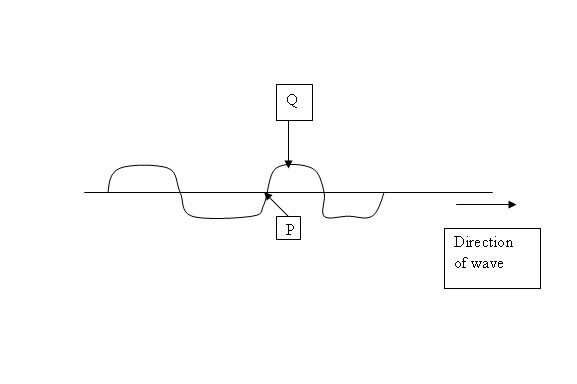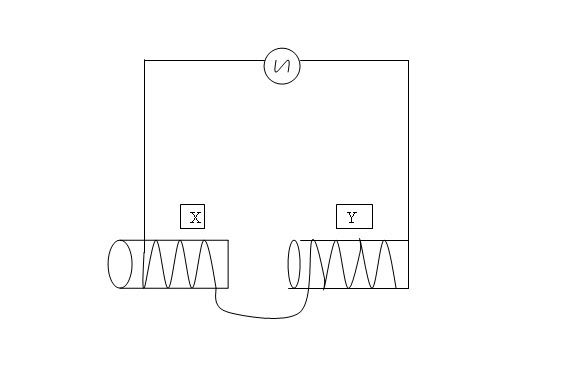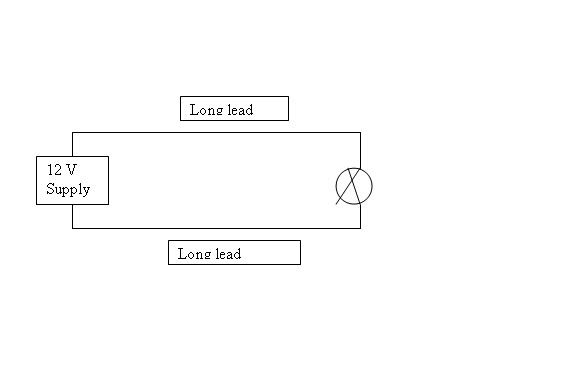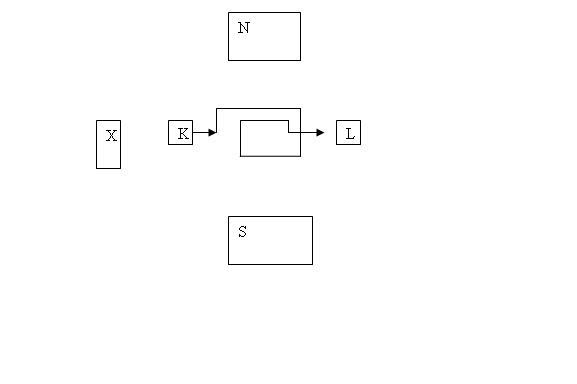Physics - 5 questions to ask
-
1. The diagram shows a transverse wave on a rope. The wave is travelling from left to right. At this instant shown, the points P and Q on the rope have zero displacement and maximum displacement respectively.

What is the direction of motion of points P and Q at this instant? (eg. Downwards, upwards, stationary)
For P, I think it's upwards while Q is stationary.
2. Two solenoids, X and Y , are connected in series as shown and are suspended near each other. When X and Y are connected to an a.c. supply, they will
A repel each other
B Attract each other
COscillate towards and away from each other
D Oscillate upwards and downwards.

3. A 12 V lamp is connected to a 12 V supply with very long leads as shown

Why does lamp glow dimly?
A. Current through lamp is less than current from supply
B P.D across each lead will be half the supply voltage
C Lamp connected wrong way round
D Electrical energy coverted to internal energy in long leads.
Eliminated C since it's totally impossible. I also ruled out D as internal energy changes when there is a change in either kinetic OR potential energy. Now left with A and B. B sounds right but I'm not sure... if yes, can someone explain why P.D across each lead will be half the supply voltage? If no, then please explain to me why it is the other answer, etc.
4.To an observer at X, in which direction does coil move?

A From L to K
B Out of paper
C Turns clockwise about axis KL
D Turns anti-clockwise about axis KL
I understand that force is downwards so I thought answer could be A or D. I think if you visualise it 3D, it will turn anti-clockwise about axis KL (moving down). Not sure if it's correct.
5. If you have 2 conducting plates
S_________N_______________ +V
R_________M_______________0
placed parallel at a fixed distance apart, what is the magnituude of the electric form experienced by a point charge as it moves along MN?
It's the same yeah? Since it's a uniform parallel conducting plate.
Thanks for reading and clarifying my doubts!
-
bump.... a bit busy now...
will reply later tonight if no one else can help
-
Can't see graphics when in office, I shall reply Q5 first
I guess you mean electric force, not electric form right?
Yes, it is the same. This is because E-field inside the parallel plates is a constant.
But there's work done hor -
1. The diagram shows a transverse wave on a rope. The wave is travelling from left to right. At this instant shown, the points P and Q on the rope have zero displacement and maximum displacement respectively.

What is the direction of motion of points P and Q at this instant? (eg. Downwards, upwards, stationary)
For P, I think it's upwards while Q is stationary.
For wave questions, think about which direction will the wave move, and as the wave move, the particles need to move up and down to complete the "motion", therefore, P should move up and Q should move down
2. Two solenoids, X and Y , are connected in series as shown and are suspended near each other. When X and Y are connected to an a.c. supply, they will
A repel each other
B Attract each other
COscillate towards and away from each other
D Oscillate upwards and downwards.

Assuming your directions of circuit is correct. Y and X will have the same induced north pole pointing right, so they will tend to attract each other, but according to , i think , Lenz laws, they will tend to repel the motion of attraction. Answer: A
3. A 12 V lamp is connected to a 12 V supply with very long leads as shown

Why does lamp glow dimly?
A. Current through lamp is less than current from supply
B P.D across each lead will be half the supply voltage
C Lamp connected wrong way round (Clearly not possible, yes)
D Electrical energy coverted to internal energy in long leads. (conductor, should not be)
Eliminated C since it's totally impossible. I also ruled out D as internal energy changes when there is a change in either kinetic OR potential energy. Now left with A and B. B sounds right but I'm not sure... if yes, can someone explain why P.D across each lead will be half the supply voltage? If no, then please explain to me why it is the other answer, etc.
The long leads will increase resistance using resistance formulae, therefore, using V=IR, increase R, V constant, therefore I decrease. So answer is A, volatage is the amount of work across a certain section of wire or any item with resistance by 1 C of charge, so although the resistance wire (Lead), will cause some work to be done, but it is not across the bulb, so V stays constant.
4.To an observer at X, in which direction does coil move?

A From L to K
B Out of paper (OUT OF CONTEXT, is see bu X not you)
C Turns clockwise about axis KL
D Turns anti-clockwise about axis KL
I understand that force is downwards so I thought answer could be A or D. I think if you visualise it 3D, it will turn anti-clockwise about axis KL (moving down). Not sure if it's correct.
current not given, question is ambiguous, however, if i use DC current from K to L, it will move right, which is neither the options, and AC curent cannot do.... Is this DC or AC system?
5. If you have 2 conducting plates
S_________N_______________ +V
R_________M_______________0
placed parallel at a fixed distance apart, what is the magnituude of the electric form experienced by a point charge as it moves along MN?
It's the same yeah? Since it's a uniform parallel conducting plate.
(SEE EAGLE SOLN)
Thanks for reading and clarifying my doubts!
-
i think 1st qn both p move up q move down . cause at max displace MUST come down. x.x